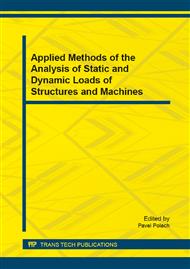[1]
S. Holý, An Invisible Danger of Schematization and Its Deleting by Means of Experiment, in: Proceedings of the 4th Bilateral German-Czech Symposium Experimental Mechanics Methods in Nondestructive Testing of Structures and Elements, Bergische Universität Wuppertal, Wuppertal, 1993, pp.1-2.
Google Scholar
[2]
S. Holý, Is an Experiment in Solid Mechanics still in Fashion?, in: Proceedings of the 5th Bilateral Czech/German Symposium Experimental Methods of Mechanics and Their Development in accordance with Numerical Modeling, ITAM and IT CzAS, Liblice, (1995).
Google Scholar
[3]
H.A. Mang, A plea for cooperation of experimental and analytical research in the field of solid mechanics, in: Proceedings of the 6th Danubia-Adria Symposium on Experimental Methods in Solid Mechanics, Seefeld, (2000).
Google Scholar
[4]
O. Šedivý, C. Krempasky, S. Holý, Residual stress measurement by electronic speckle pattern interferometry, in: Proceedings of the 5th Australasian Congress on Applied Mechanics ACAM 2007, Engineers Australia, Brisbane, 2007, pp.342-347.
Google Scholar
[5]
S. Holý, Monitoring and Control of Technology and Service Safety by Means of Experimental Mechanics, in: Abstracts of GAMM Jahrestagung 1996, Charles University in Prague, Prague, (1996).
Google Scholar
[6]
M. Vlk, M. Hrabovský, S. Holý, Experimental mechanics in solids – today and future, in: L. Houfek, P. Hlavoň, P. Krejčí (Eds. ), Proceedings of the National Conference with International Participation Engineering Mechanics 2002, Brno University of Technology, Svratka, 2002, CD-ROM.
Google Scholar
[7]
J. Anděl et al., Elastoplastic response of the pipeline TX 60 Z01 to failure in the room A 820, Research report, DITI 300/249NRI, NRI Řež, Řež, 2005. (in Czech).
Google Scholar
[8]
S. Holý, Z. Hrubý, J. Blažek, L. Pečínka, Experimental Evaluation of Material Para-meters for High-rate Phenomena Simulations with Respects to Johnson-Cook Plasticity, in: Proceedings of the 28th Danubia-Adria – Symposium on Advances in Experimental Methods, Siófok, 2011, pp.251-252.
Google Scholar
[9]
J.L. Chaboche, On some modifications of kinematic hardening to improve the description of ratchetting effects, International Journal of Plasticity 7 (1991) 661-678.
DOI: 10.1016/0749-6419(91)90050-9
Google Scholar
[10]
G.R. Johnson, W.H. Cook, Fracture Characteristics of Three Metals Subjected to Various Strains, Strain rates, Temperatures and Pressures, Engineering Fracture Mechanics 21 (1985) 31-48.
DOI: 10.1016/0013-7944(85)90052-9
Google Scholar
[11]
D. Novotný, M. Kadlec, Loading test Nr. P-PK-0012/10, CTU in Prague, Prague, 2010. (in Czech).
Google Scholar


